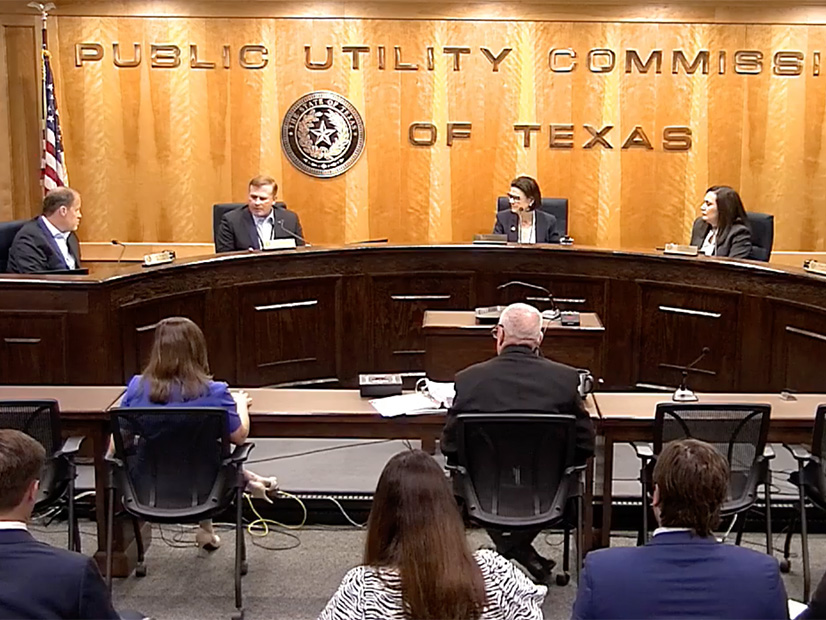During their first open meeting since the recently concluded legislative session, Texas regulators discussed their next steps in changing the ERCOT market.
Texas legislators sidestepped the Public Utility Commission’s proposed performance credit mechanism (PCM) that would pay dispatchable generators credits for being available during peak demand. Instead, they capped the PCM’s costs at $1 billion annually and passed a measure that creates a $5 billion taxpayer-funded low-interest loan program for developers who want to build gas-fired generation. (See Clean Energy Escapes Texas Legislature’s Wrath.)
To help the PUC refocus and redouble its efforts, Commissioner Will McAdams filed a memo outlining the short-term operational flexibility challenge and the long-term resource adequacy problem facing the Texas grid.
“As the session has concluded, as we now know what tools we have available in our toolbox and also to bring forward a previously filed suggested framework on reliability standards,” he said during the commission’s June 15 meeting.
McAdams reminded his fellow commissioners that the operating reserve demand curve (ORDC) retains and attracts sufficient installed capacity but that the increased penetration by wind, solar and battery resources requires additional operational flexibility. He said ERCOT’s recent heavy use of reliability unit commitments (RUC) as part of its conservative operations posture is not the answer.
Instead, McAdams suggested using a multistep floor for the ORDC that ERCOT proposed as part of its bridge to the PCM. Adding one floor at 6,500 MW of remaining reserves and a second at 7,000 MW would address the disconnect between conservative market operations and price signals to generators, he said, pointing to the ISO’s modeling that indicated applying this change in 2020 and 2022 would have resulted in annual revenues of about $500 million to primarily dispatchable resources.
“Ultimately, I believe these solutions work in tandem with the PCM,” McAdams wrote in his memo. “The adjustment to the ORDC bolsters reliability in the real time energy market, changes to ancillary service products help the day-ahead market and [create] more operational certainty, while the PCM shores up long-term planning and reliability as an availability market.
“We are at the forefront of a major energy transition. Renewables are here and more are coming,” he said during the open meeting. “The effect is having the grid operator, ERCOT, having to do more to harmonize the flow of power with what is increasingly becoming a dominant variable, a resource mix that is dominated by variable resources. We don’t have a capacity market in Texas, but we’ve got a heck of a lot of renewables, and so revenues associated with managing this are only going to increase into the future.”
Commissioner Jimmy Glotfelty agreed with McAdams, saying any market solution for ERCOT should rely on a market-driven mechanism that can be deployed in an “efficient, expeditious” manner.
“RUC is an out-of-market action that has a distortionary impact on the market and has a physical impact on our older, long-duration generation assets that are needed to ensure reliability,” Glotfelty said. “Secondly, the bridge, by driving generation self-commitment and the real-time market, is where we see revenues that will help cover their marginal costs, thereby providing revenue stability to help retain existing generation and incent investment in new generation.
“A bridge solution should fulfill the objective of stabilizing the market by sending a stronger market signal to incent self-commitment. I think ultimately, we have a proposed solution and I look forward to further evaluate and open meeting and taking action.”
Lake Absent After Resignation
The open meeting marked Kathleen Jackson’s first as the PUC’s interim chair. She was named to the position after Peter Lake announced his resignation June 2. (See Texas PUC’s Lake Steps Down as Chair.)
“Obviously, things look a little different up here today,” Jackson said, acknowledging the empty chair to her left. The commissioners excused Lake’s absence for a personal matter, though he officially leaves the panel on July 1.
She and the other commissioners thanked Lake for his “tireless dedication” to the PUC during the months following the deadly 2021 winter storm, which nearly brought down the ERCOT grid.
“He demonstrated extremely competent and able and steady leadership during that extraordinary time,” McAdams said, “when the commission, staff, ERCOT and the industry was asked to pick ourselves up, put ourselves back together and reassure the public that that ubiquitous essential service that we call electricity will remain on and will remain reliable.”
“It certainly was one of the most critically difficult and important times in the commission’s history, and stepping into a job like that is no easy job,” Commissioner Lori Cobos said. “[Lake] did the best he could to lead our agency for the last two years and implementing all the legislation that was passed.”
Following an executive session, the commissioners agreed to request the state’s attorney general file a motion with the Texas Supreme Court regarding the 3rd Court of Appeals’ recent ruling reversing a PUC scarcity-pricing order. (See Texas Appeals Court Reverses Another PUC Order.)
The appeals court ruled June 1 that the PUC violated the state’s Administrative Procedure Act’s rulemaking provisions when it approved an ERCOT protocol change related to pricing during certain extreme events. It also agreed with the lawsuit’s appellants, RWE Renewables Americas and Hereford Wind, that the order constitutes a “competition rule” and that the PUC exceeded its statutory authority with its approval (03-21-00356-CV).





